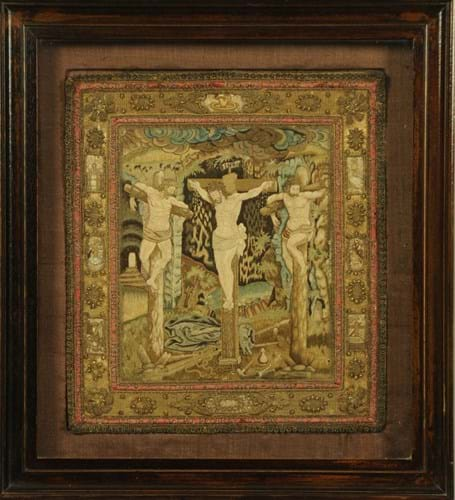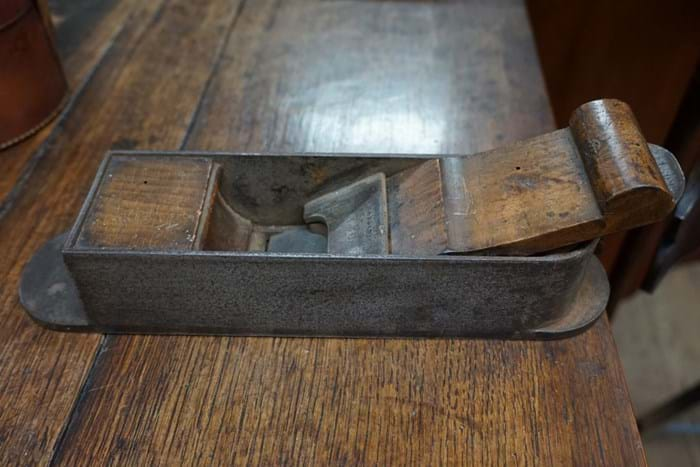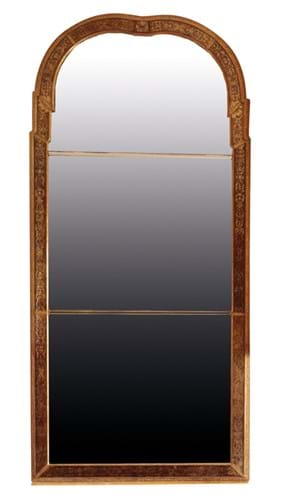1. Unique Mouseman bureau – £36,000
Yorkshire saleroom Morphets of Harrogate sold this Mouseman bureau, pictured above, for a tub-thumping £36,000 on April 15. The estimate was £10,000-12,000.
The piece, much admired for its burr oak panels, deep brown patination and attractive size at 2ft 9in (83cm) wide, is thought to be a unique design created for a client by Robert Thompson himself. A copy of the order made in 1933 to APW Greenhalgh Esq, a mill owner from Delph near Oldham, can be found in the archives at Kilburn, a photograph of which was included in the lot. The bureau, that passed to Greenhalgh’s son, was later bought back by the Robert Thompson workshop and subsequently purchased by the current owner.
Prime-period Mouseman furniture continues to enjoy a saleroom purple patch.
Landmark bids in recent years have included the £35,000 bid for a dresser dated 1930 sold as part of the Horlicks collection at Sworders in October 2018 and a £31,000 refectory table from a dining suite made for Brigadier Hargreaves of Castlegarth, Wetherby, near Leeds c.1927 at Wilkinson’s in Doncaster the following month.
Earlier this year Tennants set a series of new benchmarks for Mouseman figural carvings with the anthropomorphic ‘Mouseman of Kilburn’ selling at £13,000.
The £36,000 bid for this desk represents the second-highest ever for Mouseman, next to the $70,000 (£40,460) bid at Sotheby’s New York in 2003 for a documentary two-section oak cupboard of 1923.
2. Tea set designed by Frank Brangwyn – £2800
Between 1932 and 1934 Clarice Cliff was the art director for a project involving nearly 30 artists of the day (prompted by the Prince of Wales) to promote good design on tableware.
The Artists in Industry earthenwares were produced under her direction, and the artists included such notable names as Duncan Grant, Paul Nash, Barbara Hepworth and Vanessa Bell. The project Modern Art for the Table was launched at Harrods, London in October 1934 but received a mixed response with few of the designs, made as part of the Bizarre range, enjoying any great longevity. The most successful was the Circus range of tablewares designed by Dame Laura Knight in her distinctive linear style. Royal Academician Frank Brangwyn’s contribution was a floral-decorated Iris pattern ‘bachelor’ tea set to a geometric shape. An example of this rarity came for sale at Hansons in Etwall, Derbyshire on April 15 where it sold at £2800.
Brangwyn’s best known design for Clarice Cliff are the series of three wall chargers decorated with scenes taken from ‘The British Empire Panels’ designed for the Royal Gallery of the House of Lords in 1925.
3. 16th century book cover – £15,500
The sale at Mitchells in Cockermouth on April 14-16 included selected contents from Greystoke Castle near Penrith – home to the Howard family for over 500 years. Very much the choice entry was this 16th century needlework bible cover worked in coloured threads with The Crucifixion.
An accompanying plaque reads: “Bible cover owned by Mary Queen of Scots and given by her mother to Lady Elizabeth Stuart, later Countess of Arundel and Surrey who gave it to her son Charles Howard of Greystoke” with similar words inked to the reverse.
Estimated at £10,000-15,000, it sold at £15,500.
4. Walnut mitre plane – £3800
The choice element of a mixed lot offered by Stride & Son Chichester on April 16 was this Georgian walnut mitre plane stamped for Christopher Gabriel. Estimated at just £30-40, it attracted numerous bids before selling at £3800.
Christopher Gabriel (1746-1809) was a prolific plane maker and, as some of his business and family records survive, a surprisingly large amount is known about his life, first as an apprentice in Falmouth and later as workshop owner in London. As documented in Christopher Gabriel and the Tool Trade in 18th Century London by Jane and Mark Rees (1997), that reproduces two surviving inventories of Gabriel’s stock, he began the family business in 1770, later moving to a house and workshop in Golden Lane.
A good number of tools carrying his name survive but Gabriel mitre planes are a rare beast and only a dozen or so are recorded. They assume the box-like form, with wrought iron sides dovetailed to a two-piece steel sole, that remained popular well into the 20th century. Some carry what are thought to be serial numbers: the number 530 to this example would render it a relatively early example.
5. Queen Anne painted mirror – £48,000
Dewlish House, built in 1702 near Milborne St Andrew, Dorset has just been sold for only the second time in its history. The Grade I-listed manor was owned by the Michel family until the 1960s when, in near derelict condition, it was bought and restored by financier Anthony Boyden.
Duke’s of Dorchester dispersed the contents on April 15 describing the auction as “an unrepeatable opportunity to attend a good old fashioned house sale with everything on offer from historic portraits to china from the kitchen cupboards.”
The top-selling lot at £48,000 was this Queen Anne verre eglomise and giltwood pier mirror measuring 2.30m high x 1.09m wide. The French term verre églomisé describes a technique of applying paint and gilding to the reverse side of glass to form a decorative panel with a mirror-like surface. It was brought back into fashion in the early 18th century in France and was subsequently popularised in England by Huguenot emigres such as René and Thomas Pelletier (fl. c.1705-11).










